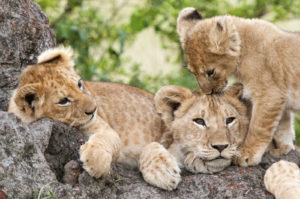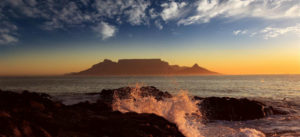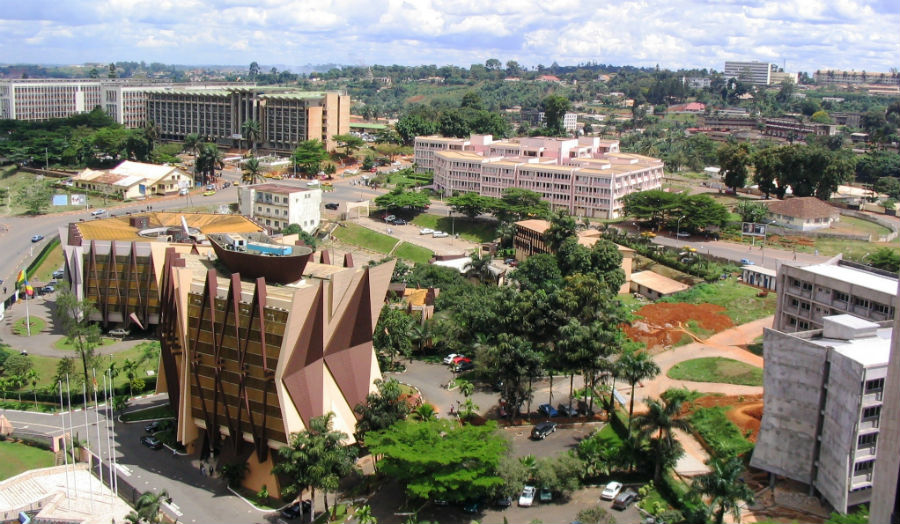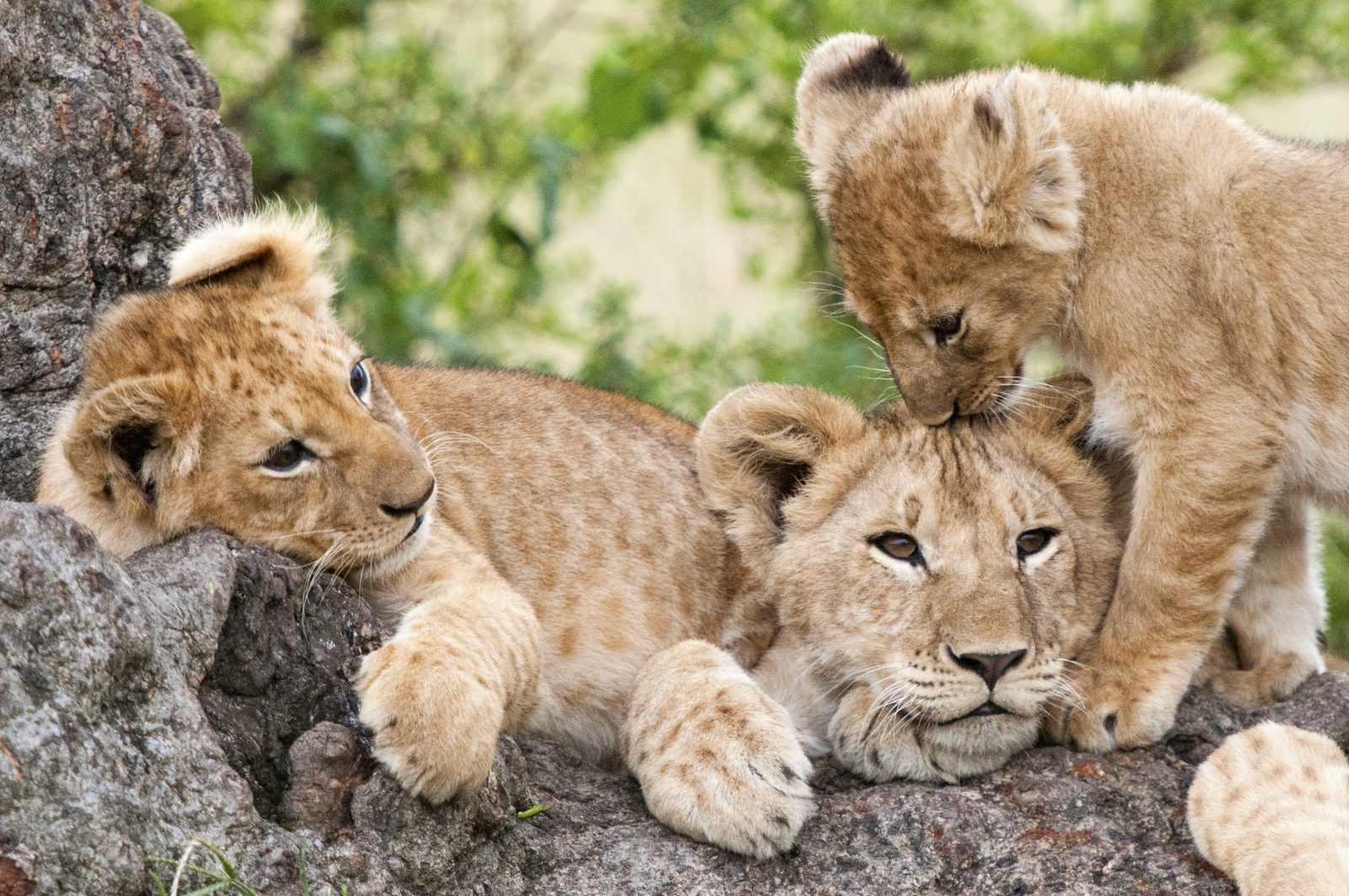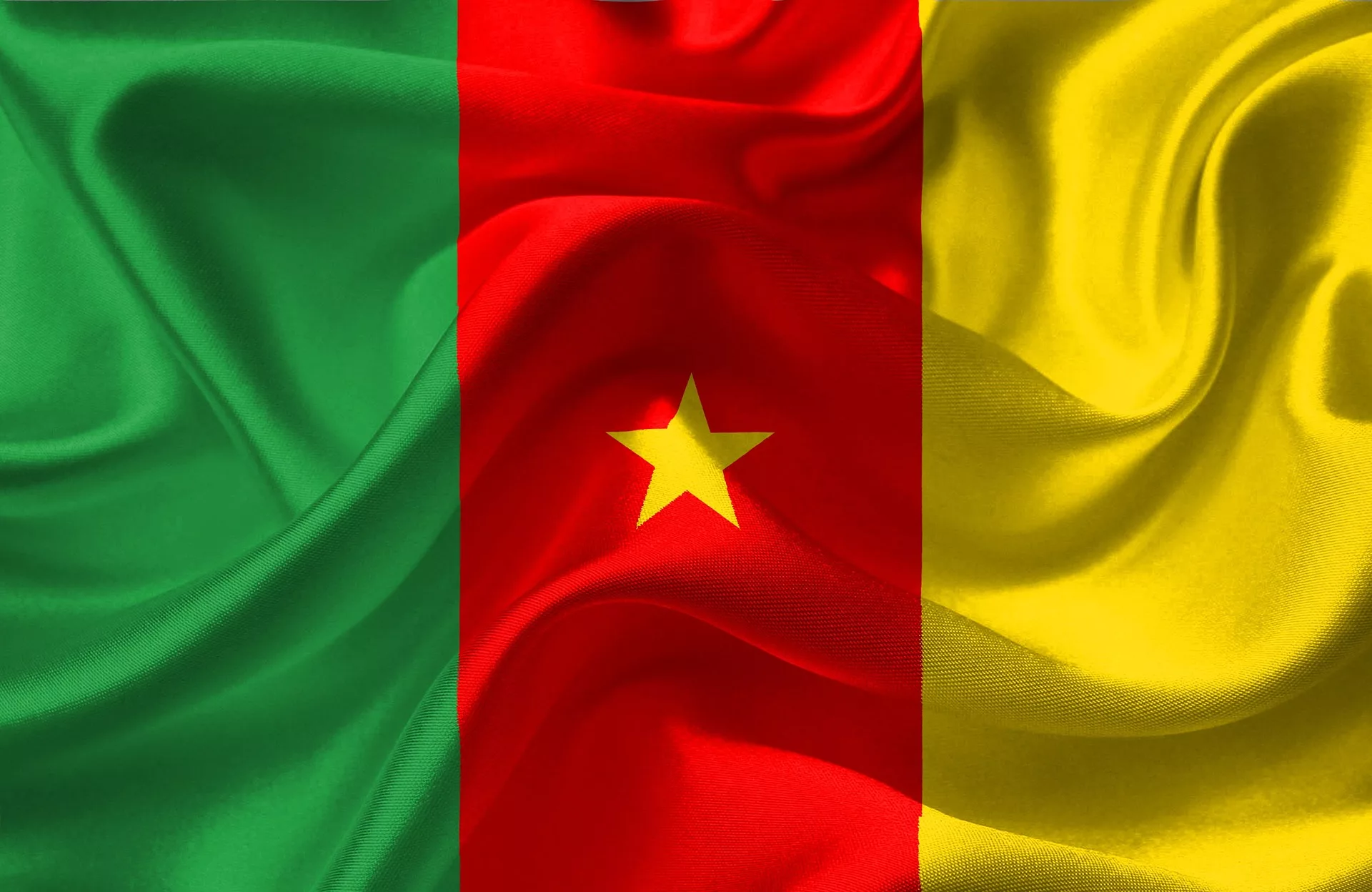 Cameroon (/ˌkæməˈruːn/ ⓘ CAM-ə-ROON; French: Cameroun), officially the Republic of Cameroon (French: République du Cameroun), is a country in Central Africa. It shares boundaries with Nigeria to the west and north, Chad to the northeast, the Central African Republic to the east, and Equatorial Guinea, Gabon and the Republic of the Congo to the south. Its coastline lies on the Bight of Biafra, part of the Gulf of Guinea and the Atlantic Ocean. Due to its strategic position at the crossroads between West Africa and Central Africa, it has been categorized as being in both camps. Its nearly 27 million people speak 250 native languages, in addition to the national tongues of English and French, or both.[11][12][13]
Cameroon (/ˌkæməˈruːn/ ⓘ CAM-ə-ROON; French: Cameroun), officially the Republic of Cameroon (French: République du Cameroun), is a country in Central Africa. It shares boundaries with Nigeria to the west and north, Chad to the northeast, the Central African Republic to the east, and Equatorial Guinea, Gabon and the Republic of the Congo to the south. Its coastline lies on the Bight of Biafra, part of the Gulf of Guinea and the Atlantic Ocean. Due to its strategic position at the crossroads between West Africa and Central Africa, it has been categorized as being in both camps. Its nearly 27 million people speak 250 native languages, in addition to the national tongues of English and French, or both.[11][12][13]
Early inhabitants of the territory included the Sao civilisation around Lake Chad, and the Baka hunter-gatherers in the southeastern rainforest. Portuguese explorers reached the coast in the 15th century and named the area Rio dos Camarões (Shrimp River), which became Cameroon in English. Fulani soldiers founded the Adamawa Emirate in the north in the 19th century, and various ethnic groups of the west and northwest established powerful chiefdoms and fondoms.
Cameroon became a German colony in 1884 known as Kamerun. After World War I, it was divided between France and the United Kingdom as League of Nations mandates. The Union des Populations du Cameroun (UPC) political party advocated independence, but was outlawed by France in the 1950s, leading to the national liberation insurgency fought between French and UPC militant forces until early 1971. In 1960, the French-administered part of Cameroon became independent, as the Republic of Cameroun, under President Ahmadou Ahidjo. The southern part of British Cameroons federated with it in 1961 to form the Federal Republic of Cameroon. The federation was abandoned in 1972. The country was renamed the United Republic of Cameroon in 1972 and back to the Republic of Cameroon in 1984 by a presidential decree by president Paul Biya. Biya, the incumbent president, has led the country since 1982 following Ahidjo’s resignation; he previously held office as prime minister from 1975 onward. Cameroon is governed as a Unitary Presidential Republic.
The official languages of Cameroon are French and English, the official languages of former French Cameroons and British Cameroons. Christianity is the majority religion in Cameroon, with significant minorities practising Islam and traditional faiths. It has experienced tensions from the English-speaking territories, where politicians have advocated for greater decentralisation and even complete separation or independence (as in the Southern Cameroons National Council). In 2017, tensions over the creation of an Ambazonian state in the English-speaking territories escalated into open warfare.
Large numbers of Cameroonians live as subsistence farmers. The country is often referred to as “Africa in miniature” for its geological, linguistic and cultural diversity.[14][11] Its natural features include beaches, deserts, mountains, rainforests, and savannas. Its highest point, at almost 4,100 metres (13,500 ft), is Mount Cameroon in the Southwest Region. Its most populous cities are Douala on the Wouri River, its economic capital and main seaport; Yaoundé, its political capital; and Garoua. Limbé in the southwest has a natural seaport. Cameroon is well known for its native music styles, particularly Makossa, Njang and Bikutsi, and for its successful national football team. It is a member state of the African Union, the United Nations, the Organisation Internationale de la Francophonie (OIF), the Commonwealth of Nations, Non-Aligned Movement and the Organisation of Islamic Cooperation.
Early history[edit]

Present-day Cameroon was first settled in the Neolithic Era. The longest continuous inhabitants are groups such as the Baka (Pygmies).[17] From there, Bantu migrations into eastern, southern and central Africa are believed to have occurred about 2,000 years ago.[18] The Sao culture arose around Lake Chad, c. 500 CE, and gave way to the Kanem and its successor state, the Bornu Empire. Kingdoms, fondoms, and chiefdoms arose in the west.[19]
Portuguese sailors reached the coast in 1472. They noted an abundance of the ghost shrimp Lepidophthalmus turneranus in the Wouri River and named it Rio dos Camarões (Shrimp River), which became Cameroon in English.[20] Over the following few centuries, European interests regularised trade with the coastal peoples, and Christian missionaries pushed inland.[21]
In 1896, Sultan Ibrahim Njoya created the Bamum script, or Shu Mom, for the Bamum language.[22][23] It is taught in Cameroon today by the Bamum Scripts and Archives Project.[23]
German rule[edit]
Germany began to establish roots in Cameroon in 1868 when the Woermann Company of Hamburg built a warehouse. It was built on the estuary of the Wouri River. Later, Gustav Nachtigal made a treaty with one of the local kings to annex the region for the German emperor.[24] The German Empire claimed the territory as the colony of Kamerun in 1884 and began a steady push inland; the natives resisted. Under the aegis of Germany, commercial companies were local administrations. These concessions used forced labour to run profitable banana, rubber, palm oil, and cocoa plantations.[24] Even infrastructure projects relied on a regimen of forced labour. This economic policy was much criticised by the other colonial powers.[25]
French and British rule[edit]
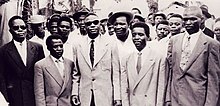
With the defeat of Germany in World War I, Kamerun became a League of Nations mandate territory and was split into French Cameroon (French: Cameroun) and British Cameroon in 1919. France integrated the economy of Cameroon with that of France[26] and improved the infrastructure with capital investments and skilled workers, modifying the colonial system of forced labour.[25]
The British administered their territory from neighbouring Nigeria. Natives complained that this made them a neglected “colony of a colony”. Nigerian migrant workers flocked to Southern Cameroons, ending forced labour altogether but angering the local natives, who felt swamped.[27] The League of Nations mandates were converted into United Nations Trusteeships in 1946, and the question of independence became a pressing issue in French Cameroon.[26]
France outlawed the pro-independence political party, the Union of the Peoples of Cameroon (Union des Populations du Cameroun; UPC), on 13 July 1955.[28] This prompted a long guerrilla war waged by the UPC and the assassination of several of the party’s leaders, including Ruben Um Nyobè, Félix-Roland Moumié and Ernest Ouandie. In the British Cameroons, the question was whether to reunify with French Cameroon or join Nigeria; the British ruled out the option of independence.[29]
Independence[edit]

On 1 January 1960, French Cameroun gained independence from France under President Ahmadou Ahidjo. On 1 October 1961, the formerly British Southern Cameroons gained independence from the United Kingdom by vote of the UN General Assembly and joined with French Cameroun to form the Federal Republic of Cameroon, a date which is now observed as Unification Day, a public holiday.[30] Ahidjo used the ongoing war with the UPC to concentrate power in the presidency, continuing with this even after the suppression of the UPC in 1971.[31]
His political party, the Cameroon National Union (CNU), became the sole legal political party on 1 September 1966 and on 20 May 1972, a referendum was passed to abolish the federal system of government in favour of a United Republic of Cameroon, headed from Yaoundé.[32] This day is now the country’s National Day, a public holiday.[33] Ahidjo pursued an economic policy of planned liberalism, prioritising cash crops and petroleum development. The government used oil money to create a national cash reserve, pay farmers, and finance major development projects; however, many initiatives failed when Ahidjo appointed unqualified allies to direct them.[34]
The national flag was changed on 20 May 1975. Two stars were removed, replaced with a large central star as a symbol of national unity.
Ahidjo stepped down on 4 November 1982 and left power to his constitutional successor, Paul Biya. However, Ahidjo remained in control of the CNU and tried to run the country from behind the scenes until Biya and his allies pressured him into resigning. Biya began his administration by moving toward a more democratic government, but a failed coup d’état nudged him toward the leadership style of his predecessor.[35]
An economic crisis took effect in the mid-1980s to late 1990s as a result of international economic conditions, drought, falling petroleum prices, and years of corruption, mismanagement, and cronyism. Cameroon turned to foreign aid, cut government spending, and privatised industries. With the reintroduction of multi-party politics in December 1990, the former British Southern Cameroons pressure groups called for greater autonomy, and the Southern Cameroons National Council advocated complete secession as the Republic of Ambazonia.[36] The 1992 Labour Code of Cameroon gives workers the freedom to belong to a trade union or not to belong to any trade union at all. It is the choice of a worker to join any trade union in their occupation, since there is more than one trade union in each occupation.[37]
From Wikipedia, the free encyclopedia


